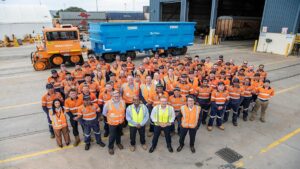Rio Tinto’s Strategic Move: Local Production of Iron Ore Rail Cars in Western Australia
In a significant development within the mining sector, metals and mining giant Rio Tinto has officially commenced the production of its first iron ore rail cars in Western Australia (WA). This initiative marks a pivotal step in bolstering local manufacturing and reinforces Rio Tinto’s commitment to operational efficiency and economic development in the region.
Investment and Job Creation
Rio Tinto is pouring A$150 million (approximately $94.8 million) into procuring 100 state-of-the-art rail cars for its operations in the Pilbara region. This move is not just about enhancing operational capabilities; it is expected to create up to 25 new jobs in Pilbara, contributing to the local economy and bolstering the workforce within this vital area.
Collaborative Manufacturing Efforts
The production of these rail cars is taking place in partnership with Gemco Rail and CRRC Qiqihar Rolling Stock, backed by robust support from the WA government. This collaboration is designed to establish a localized supply chain and enhance manufacturing capacities in the region, promoting economic sustainability.
The first batch of 40 rail cars is already under production at Gemco’s facility in Forrestfield, Perth. Notably, a new manufacturing workshop in Karratha will take on the task of producing an additional 60 rail cars later this year, highlighting the company’s dedication to expanding its operational footprint in WA.
Government Support and Local Investments
To aid the upgrade and establishment of its facilities, Gemco Rail has secured a grant of A$6.9 million (approximately $4.3 million) from the WA Government’s Local Manufacturing Investment Fund (LMIF). This funding is crucial for enhancing the infrastructure at the Forrestfield site as well as for developing the Karratha facility.
In addition, another grant of A$340,929 (around $215,512) has been earmarked for modernizing equipment at the Forrestfield site. This investment not only boosts local production capabilities but has also paved the way for Gemco to secure a contract to provide 40 rail wagons to BHP, further highlighting the burgeoning manufacturing ecosystem in WA.
The LMIF has now invested over $13.5 million (approximately $8.5 million) into local manufacturing projects, showcasing the government’s commitment to fostering a sustainable manufacturing environment in the region.
Premier’s Vision for Economic Diversification
Western Australian Premier Roger Cook expressed his support for this initiative, stating, “Our vision for Western Australia’s future is clear: we want to continue working closely with the resources industry to diversify our nation-leading economy and make more things here.” This sentiment underlines the collaborative spirit between the government and the industry, positioning Western Australia as a hub for manufacturing innovation.
Advanced Technology and Future Prospects
Gemco Rail is leveraging advanced engineering techniques and robotic welding technologies to produce rail cars that can transport up to 118 tonnes of iron ore from Rio Tinto’s 17 mines to its ports. The Karratha workshop is set to provide not only new rail cars but also refurbished rail car bearings, minimizing the need for transportation from Perth and enhancing operational efficiency.
The first locally manufactured rail cars are set to enter service in the Pilbara region by the first half of 2025, marking a significant milestone in the advancement of local manufacturing capabilities.
Rio Tinto Iron Ore’s chief executive Simon Trott remarked, “By partnering with Gemco Rail and CRRC Qiqihar Rolling Stock, we are establishing new manufacturing capabilities in the Pilbara that will create a reliable and sustainable supply chain to support our operations and the regional economy for years to come.”
Conclusion
As Rio Tinto embarks on this ambitious initiative, it exemplifies the potential for local manufacturing to support economic growth and innovation in the mining sector. With a commitment to sustainability, job creation, and technological advancement, this development is set to redefine the landscape of iron ore transportation and manufacturing in Western Australia.
Stay tuned for more insights and updates from Extreme Investor Network as we continue to track the developments in the finance and investment landscape.

